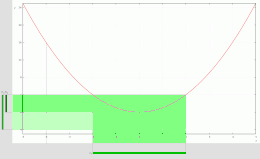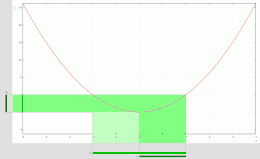Image (mathematics)
In mathematics, the image of a function is the set of all output values it may produce.

| Algebraic structure → Group theory Group theory |
|---|
 |
More generally, evaluating a given function at each element of a given subset of its domain produces a set, called the "image of under (or through) ". Similarly, the inverse image (or preimage) of a given subset of the codomain of is the set of all elements of the domain that map to the members of
Image and inverse image may also be defined for general binary relations, not just functions.
Definition
The word "image" is used in three related ways. In these definitions, is a function from the set to the set
Image of an element
If is a member of then the image of under denoted is the value of when applied to is alternatively known as the output of for argument
Given the function is said to "take the value " or "take as a value" if there exists some in the function's domain such that Similarly, given a set is said to "take a value in " if there exists some in the function's domain such that However, " takes [all] values in " and " is valued in " means that for every point in 's domain.
Image of a subset
Throughout, let be a function. The image under of a subset of is the set of all for It is denoted by or by when there is no risk of confusion. Using set-builder notation, this definition can be written as[1][2]
This induces a function where denotes the power set of a set that is the set of all subsets of See § Notation below for more.
Image of a function
The image of a function is the image of its entire domain, also known as the range of the function.[3] This last usage should be avoided because the word "range" is also commonly used to mean the codomain of
Generalization to binary relations
If is an arbitrary binary relation on then the set is called the image, or the range, of Dually, the set is called the domain of
Inverse image
Let be a function from to The preimage or inverse image of a set under denoted by is the subset of defined by
Other notations include and [4] The inverse image of a singleton set, denoted by or by is also called the fiber or fiber over or the level set of The set of all the fibers over the elements of is a family of sets indexed by
For example, for the function the inverse image of would be Again, if there is no risk of confusion, can be denoted by and can also be thought of as a function from the power set of to the power set of The notation should not be confused with that for inverse function, although it coincides with the usual one for bijections in that the inverse image of under is the image of under
Notation for image and inverse image
The traditional notations used in the previous section do not distinguish the original function from the image-of-sets function ; likewise they do not distinguish the inverse function (assuming one exists) from the inverse image function (which again relates the powersets). Given the right context, this keeps the notation light and usually does not cause confusion. But if needed, an alternative[5] is to give explicit names for the image and preimage as functions between power sets:
Arrow notation
- with
- with
Star notation
- instead of
- instead of
Other terminology
- An alternative notation for used in mathematical logic and set theory is [6][7]
- Some texts refer to the image of as the range of [8] but this usage should be avoided because the word "range" is also commonly used to mean the codomain of
Examples
- defined by The image of the set under is The image of the function is The preimage of is The preimage of is also The preimage of under is the empty set
- defined by The image of under is and the image of is (the set of all positive real numbers and zero). The preimage of under is The preimage of set under is the empty set, because the negative numbers do not have square roots in the set of reals.
- defined by The fibers are concentric circles about the origin, the origin itself, and the empty set (respectively), depending on whether (respectively). (If then the fiber is the set of all satisfying the equation that is, the origin-centered circle with radius )
- If is a manifold and is the canonical projection from the tangent bundle to then the fibers of are the tangent spaces This is also an example of a fiber bundle.
- A quotient group is a homomorphic image.
Properties
| Counter-examples based on the real numbers defined by showing that equality generally need not hold for some laws: |
|---|
 Image showing non-equal sets: The sets and are shown in blue immediately below the -axis while their intersection is shown in green. |
 |
 |
General
For every function and all subsets and the following properties hold:
| Image | Preimage |
|---|---|
(equal if for instance, if is surjective)[9][10] |
(equal if is injective)[9][10] |
| [9] | |
| [11] | [11] |
| [11] | [11] |
Also:
Multiple functions
For functions and with subsets and the following properties hold:
Multiple subsets of domain or codomain
For function and subsets and the following properties hold:
| Image | Preimage |
|---|---|
| [11][12] | |
| [11][12] (equal if is injective[13]) |
|
| [11] (equal if is injective[13]) |
[11] |
(equal if is injective) |
|
The results relating images and preimages to the (Boolean) algebra of intersection and union work for any collection of subsets, not just for pairs of subsets:
(Here, can be infinite, even uncountably infinite.)
With respect to the algebra of subsets described above, the inverse image function is a lattice homomorphism, while the image function is only a semilattice homomorphism (that is, it does not always preserve intersections).
See also
- Bijection, injection and surjection – Properties of mathematical functions
- Fiber (mathematics) – Set of all points in a function's domain that all map to some single given point
- Image (category theory) – term in category theory
- Kernel of a function – Equivalence relation expressing that two elements have the same image under a function
- Set inversion – Mathematical problem of finding the set mapped by a specified function to a certain range
Notes
- "5.4: Onto Functions and Images/Preimages of Sets". Mathematics LibreTexts. 2019-11-05. Retrieved 2020-08-28.
- Paul R. Halmos (1968). Naive Set Theory. Princeton: Nostrand. Here: Sect.8
- Weisstein, Eric W. "Image". mathworld.wolfram.com. Retrieved 2020-08-28.
- Dolecki & Mynard 2016, pp. 4–5.
- Blyth 2005, p. 5.
- Jean E. Rubin (1967). Set Theory for the Mathematician. Holden-Day. p. xix. ASIN B0006BQH7S.
- M. Randall Holmes: Inhomogeneity of the urelements in the usual models of NFU, December 29, 2005, on: Semantic Scholar, p. 2
- Hoffman, Kenneth (1971). Linear Algebra (2nd ed.). Prentice-Hall. p. 388.
- See Halmos 1960, p. 31
- See Munkres 2000, p. 19
- See p.388 of Lee, John M. (2010). Introduction to Topological Manifolds, 2nd Ed.
- Kelley 1985, p. 85
- See Munkres 2000, p. 21
References
- Artin, Michael (1991). Algebra. Prentice Hall. ISBN 81-203-0871-9.
- Blyth, T.S. (2005). Lattices and Ordered Algebraic Structures. Springer. ISBN 1-85233-905-5..
- Dolecki, Szymon; Mynard, Frederic (2016). Convergence Foundations Of Topology. New Jersey: World Scientific Publishing Company. ISBN 978-981-4571-52-4. OCLC 945169917.
- Halmos, Paul R. (1960). Naive set theory. The University Series in Undergraduate Mathematics. van Nostrand Company. ISBN 9780442030643. Zbl 0087.04403.
- Kelley, John L. (1985). General Topology. Graduate Texts in Mathematics. Vol. 27 (2 ed.). Birkhäuser. ISBN 978-0-387-90125-1.
- Munkres, James R. (2000). Topology (Second ed.). Upper Saddle River, NJ: Prentice Hall, Inc. ISBN 978-0-13-181629-9. OCLC 42683260.
This article incorporates material from Fibre on PlanetMath, which is licensed under the Creative Commons Attribution/Share-Alike License.